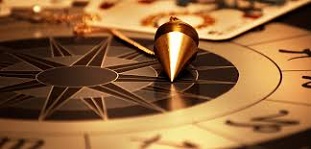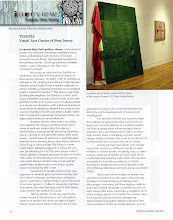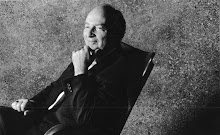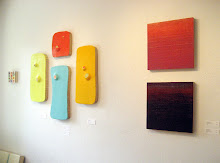.
"From
the rigorous flatness of hard edge painting to the celestial expanse of
color field work, color can enhance or defy the flatness of the canvas,
and activate the work in an exciting variety of ways. Dialogues of
translucence and opacity, movement and stasis, surface and depth are
played out through the use of color in the work of different abstract
artists."
--Jonathan D. Lippincott, curator of Chromatic Space
 Chromatic Space
Chromatic Space is
on exhibition at the Shirley Fiterman Art Center in Lower Manhattan
through November 5. It's the third exhibition this year to celebrate the
80th Anniversary of
American Abstract Artists. (My walk-through of The Onward of Art, which took place early in the year, is here.) Sixty-five
current members are represented, along with three past members and five
invited guests. This post will give you a sense of the show, which
spreads out in the Fiterman Art Center's three galleries. Because I am a
member of AAA with a painting in the show, I cannot make this a review
or even a report, but I can take you through it photographically.
The
Fiterman Art Center consists
of three spaces: Gallery A, a large space with two walls of windows
illuminating two exhibition walls; Gallery B, a long hallway wide enough
to allow the viewer to step back to see the work on its walls; and past
that, Gallery C, a large exhibition hall with windows at one end. We
start in Gallery A and move clockwise around the room. Given that the
thesis of the show is color, you will see shifts and relationships as we
move around this gallery, and from one gallery to another.
In Gallery A, a panorama of two walls. The entrance is behind that far wall. Click pic to enlarge
From left: Merrill Wagner, 6 Brands of Naples Yellow, 2009, oil on linen; and George Sugarman sculpture, Yellow X, 1994, acrylic on aluminum
(I'm including titles in the group shots and more specific information
in the individual images, but because you can get a sense of scale from
the installations, I've skipped the dimensions)
Sugarman and Wagner; then from left, seen here and below: Iona Kleinhut, Twilight; Lynn Umlauf, 7.30, 1994 (top), and Babe Shapiro, Calcium Night Lite; Irene Lawrence, To Get There/9
To the right of Sugarman: Claire Seidl; Jeanne Wilkinson; Gail Gregg; Susan Bonfils, Orion; Stephen Westfall
Claire Seidl, Second Nature, 2005, oil on linen
Jeanne Wilkinson,
Crossings 2, 2000-2016, watercolor, ink and graphite on paper. This work is shown framed
Gail Gregg,
Flicker, 2003, encaustic on panel
Stephen Westfall, Persona, 2009, oil and alkyd on canvas
On the wall just to the right of Westfall's painting is this one by Siri Berg: The Black Sheep, 2015,
oil on board, 60 x 10 x 1 inch. (I've given you dimensions because you
don't see this painting in relation to the others.)
A retrospective of the nonagenarian Berg, curated by Peter Hionas, will be the show after this
We're swinging around Gallery A to this wall, which is the one you see
from a distance when you enter from the street. From left: Vincent
Longo, Don Voisine, Roger Jorgensen, Robert Murray
Vincent Longo, Lattice Spread Yellow, 2012, acrylic on canvas
Panorama with Voisine, Jorgensen, Murray; Philis Ideal, Richard Timperio
Click pic to enlarge
Don Voisine, Noir (Confidential), 2016, oil on wood panel
Roger Jorgensen, Figures on the Beach, 1953, oil on linen
Robert Murray, Kings Penn Road, 2008, aluminum
Philis Ideal, Heap, 2012, acrylic, collage, resin on panel
Richard Timperio, Green Line, 2016, acrylic on canvas
Ldeal, Timperio and Clement Meadmore
Clement Meadmore, Elaboration, 1997, bronze
Photo: Fiterman/AAA
Ronald Bladen, Flying Fortress (model), 1974-1978, painted wood
Photo: Fiterman/AAA
Having made a complete tour of Gallery A, we're walking toward Gallery
B. Emily Berger's painting is in the distance. You'll see it in closer
view as you scroll down
With Longo and Voisine over our left shoulder, we look back into Gallery
A and over to the first work in Gallery B: Katinka Mann, Gone To, 2015, flattened sculptural painting
Mann; Lorenza Sannai, Diagramma, 2016, acrylic on canvas
Sannai; Raquel Rabinovich, I am Between Heaven and Earth 1, 1986-87, monotype on Arches paper; Emily Berger
Emily Berger, Morning, 2016, oil on wood
Photo: the artist
Though I shot these two works from the opposite direction, they follow Berger's work on the wall:
Marvin Brown, Untitled, 2015, digital print; James Seawright and Mimi Garrard, Chromatic #1, 2016, digital print
Foreground: Ramon S. Alcolea, Rain and Moon, 2016, wood; center top: Judith Murray, Strider, 1981, oil on linen; David McKenzie, #13-2011-N1, 2011, acrylic on engineered canvas; John Obuck
John Obuck, Thirteen Over One (Ghost Version), 2016, oil on canvas
Here's a view of the wall from the opposite direction. (I'll show you the opposite wall on our way back)
Lynne Harlow, Baker Bridge Road 1, 2015, acrylic on Plexiglass, 4 x 4 x 1 inch
James Gross, Winter, 2003, collage on canvas
Martin Ball, Untitled; Cecily Kahn, Untitled
Ce Roser, Cloud Geography, 1983, oil on canvas
Roser; Irene Rousseau,
Stretching the Space 11, 2016, oil on canvas
Panoramic view of two walls in Gallery C
Click pic to enlarge
Manfred Mohr, P1611_5220, 2013-13, pigment in on canvas
Victoria Burge, Light Study 1, 2015, relief print with embossing
Gabriele Evertz, Grays and Metallics (Tallit), 2014, acrylic on canvas
Daniel Hill, #9504, 1995, acrylic on two canvases
Photo: Anne Russinof
Mark Williams, Stand Out, 2010, acrylic latex on linen
Power Boothe, Ellipsis #39, 2016, gouache on paper
Joanne Mattera, Chromatic Geometry 28, 2015, encaustic on panel
Henry Brown, Parallel, 2015, acrylic, pencil, gesso on canvas
Thornton Willis, Stones of Jerusalem, 1986, casein on paper
James Rosati, Penine 1, 1963, bronze
Foreground: Alice Adams, Roof Landing model, 1985, wood and copper-coated plastic; Lucio Pozzi, Pleasant Dissatisfaction, 2016, acrylic on board
View of Gallery C from the far end of the space
James Juszczyk, Cool & Lucid, 2016, acrylic on canvas (top); Sharon Brant, Throwing a Die to Fill in Space #4, 1977, Nu-pastel and graphite pencil on black paper
Creighton Michael, Chronicle 616, 2016, layered acrylic with digital transfer on wood panel
Julian Jackson,View 1, 2016, oil on canvas
Mary Schiliro, Skinny Dip 3, 2016, acrylic on Mylar
Stephen Maine, P16-0321, 2016, acrylic on canvas
Michael, Jackson, Schiliro, Maine; James O. Clark
James O. Clark, Violaceous, 2012, vinyl, argon, light
Panorama of opposite two walls in Gallery C
Click pic to enlarge
Kim Uchiyama; Jane Logemann, b-blue; Steven Alexander
Kim Uchiyama, Light Study #41, 2016, oil on linen
Steven Alexander, Source, 2013, acrylic on canvas
Nola Zirin, Moon Game, 2016, oil, enamel, glitter, mixed media on panel
Mara Held, Doorkeeper, 2016, egg tempera on linen over panel
Li .Trincere, Black 2, 2016, acrylic on canvas; Anne Russinof; Marthe Keller, Raucous, 2007, acrylic on linen
Anne Russinof, Dervish, 2015, oil on canvas
Two views
Jim Osman, Yard, 2015, wood, paint, tree section
View of Gallery C during the opening
Photo: Fiterman/AAA
Now we walk back through Gallery B, looking at the work on our left . . .
Robert Swain, Untitled: ID #BS-232, 2016, acrylic on birch panel
Swain; Corey Postiglione, Tango Interlude #26, 2016, acrylic on canvas
Mark Dagley, Mystery of the Grail, 2015, acrylic on canvas; Nancy Manter; Clover Vail
Nancy Manter, Drive-By #3-4, 2015, flashe and charcoal on Yupo
Clover Vail, Untitled, 2016, sumi ink and ballpoint pen on wood panel
Edward Shalala, Untitled: Rocky River Reverse, Ohio, 2011, #10 raw canvas thread, documentary photography (top); Susan Smith, Mirrors, Plexi, Canvas, 2015, found mirrors and plexi with oil on canvas panels
Vera Vasek, Core Rotation, 2016, acrylic, particulates on Plexiglas
Curator Jonathan D. Lippincott
Photo: Fiterman/AAA
If I may be permitted a brief post-walk-through remark, I'd like to note
not only the range of aesthetic expression, as Lippincott did in the
comment that opened this post, but the period over which these works
were created. The curator selected some paintings and sculptures that
were made in previous decades, while in other instances he selected
paintings newly off the easel. To me the chronologic diversity added
depth not only to the history of American Abstract Artists as a group,
but also to abstraction in general.
Chromatic Space is up through November 5 at the Shirley Fiterman Art Center. The galleries are open five days a week. Info
here.
Added 10.7.16: See a
video of the exhibition with commentary by the curator, Jonathan D. Lippincott


















































































 Traduction
Traduction






